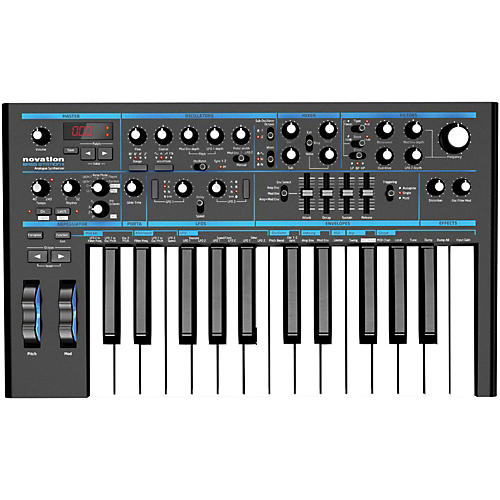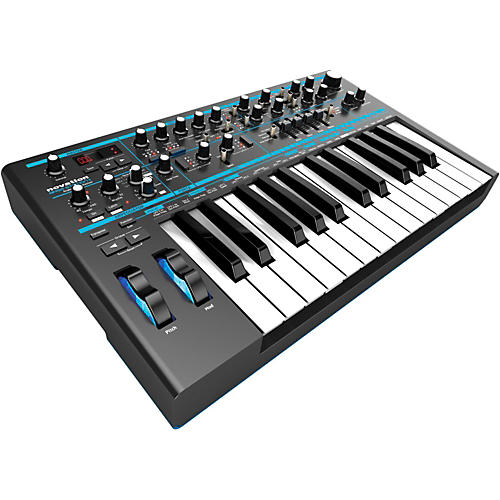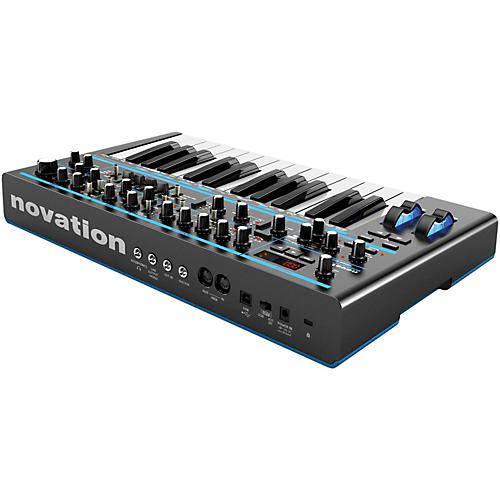Novation Bass Station II Analog Synthesizer
Novation Bass Station II Analog Synthesizer is backordered and will ship as soon as it is back in stock.
Couldn't load pickup availability
Delivery and Shipping
Delivery and Shipping
Add some general information about your delivery and shipping policies.
How long does the delivery usually take?
- For In Stock items, the delivery usually takes 2-5 business days.
- For Manufacturer In Stock items, the delivery usually takes 3-7 business days.
- For Pre-order items, the items usually ship within 1-2 weeks.
Don't Worry You can contact us any time @ 9888 48 2222
Description
Description
The classic Novation Bass Station, reworked for the 21st century.
Bass Station II is an analog mono-synth with a talent for bass, but a sound engine that is versatile enough to kick out sharp leads and crisp arpeggios. It brings the best elements of the original Bass Station into a brand-new design with reworked modulation, effects, filters and more; like the Bass Station, but much much bigger.
The signal path is pure analog—including the effects section. The hardware has been laid out in modules with dedicated pots, switches, sliders and buttons for all major parameters. Critically, you can store and recall patches on Bass Station II. It comes with 64 killer factory presets, space for 64 of your own sounds on the hardware, and the ability to store more on your computer.
The key mechanism consists of 25 full-sized keys that are velocity sensitive with assignable aftertouch. It has been developed as a synth-action keyboard, where each key is individually sprung so it is light to the touch and highly responsive to the synth engine. Bass Station II is a fully class-compliant MIDI device with MIDI I/O on 5-pin din ports—for connecting to other MIDI outboard—and can interface with your computer over USB.
The Synth Engine: A Brief Overview
Oscillators: Bass Station II is built on three analog oscillators and a noise generator. There are two fully independent oscillators plus a sub oscillator (which is the critical component in creating rich, analog bass sounds). Oscillators One and Two are switchable between sine, sawtooth, square and variable pulse width, and Oscillator Three—the sub Osc—can be set to one or two octaves below Oscillator One. It can be square, sine or narrow pulse width, delivering the characteristically "fat" bass tone.
Filters: You can select between two discrete filters—Acid or Classic—each with a built-in overdrive for pushing filter tones from dry, to warm, to nasty. The Classic Bass Station filter can be switched between low pass, high pass and band pass at 12 or 24dB slopes. The Acid filter is based on a diode ladder filter design that delivers a characteristically 303-style sound that is designed to squelch.
Effects: Bass Station II has two effects (not including the filter overdrive). Analog distortion drives circuit components to add new frequencies to the sound. Bass Station II's Distortion function can add gentle warmth, filthy granularity and anything in between. The second effect is Osc Filter Mod, which creates a distinctive FM-type sound by using Oscillator Two to modulate the filter frequency. This is very good at crunchy, sound-mulching effects that substantially fatten up bass and lead patches.
Modulation: There are two envelope generators and two low frequency oscillators (LFOs). The first envelope is an ADSR amp envelope and the second is a mod envelope that can be used to modulate filter frequency, oscillator pitch and OSC pulse width. LFO One is dedicated to pitch modulation whereas LFO Two is used to modulate OSC pulse width and filter frequency. Although it looks like there are four LFO waveforms, the LFO Slew function can be used freely to sculpt LFOs into smoother wave shapes.
Arpeggiator and Step Sequencer: Bass Station II's Arpeggiator and Step Sequencer are killer performance and production tools. The Arp can be directed to run through 32 different rhythmic patterns in different directions with a switchable octave range. The fun really starts when you engage the Step Sequencer. Up to four sequences can be played in—with legato and rests—and assigned to any one of the 32 rhythmic patterns. As well as getting ideas down quickly and programming performance sequences, this is a brilliant way to preview patches while you are editing them.
Bass Station II v2.5
The v2.5 firmware update adds some of the most requested features including filter tracking, paraphonic mode, microtuning and new preset Soundpacks. Installation couldn't be easier from the Novation Components content manager.
Paraphonic mode
Bass Station II is now a paraphonic monosynth because you can control the pitches of each of the two oscillators separately in its single-voice architecture. Play two notes at a time rather than just one and get interesting interactions through the Ring and Filter Mod.
Filter tracking
Filter tracking was one of your most requested features. The filter includes variable keyboard tracking in Bass Station II v2.5—the best for matching higher notes to increased brightness.
Envelope retriggering
Bass Station II's secret sound-design weapon is envelope retriggering. It’s now possible to configure your envelopes to retrigger once the decay stage has ended, opening up a whole range of new possibilities.
Oscillator error
Oscillator error introduces a small and adjustable random detune on each note-on event. This can be used to generate some very beautiful, subtle (or not) musical dissonance, very much in the same way that vintage synths do (because of the looser tolerance of their electronic components). Paraphonic mode makes it as dramatic as possible.
Microtuning editing
Completely control the frequency triggered by each key press, giving your scales another dimension.
New presets
Two new Soundpacks are in Components: Silver and Sinevibes. Silver's presets explore the v2.5 features and inspire new tracks and sound design. Sinevibes, designed by Sinevibes’ founder Artemij Pavlov, gives 101 classic Bass Station II presets.
Warm greetings to you all
Bass Station II can now support a custom message display at start-up.
Features
Analog synth: brand-new version of the classic Bass Station
Two distinct analog filters: brand new "Acid" filter joins the "Classic" original Bass Station filter
Bass Station II ships with 64 factory patches and a further 64 user slots
Patch dump enables you to archive and swap sounds
Pattern-based Step Sequencer and Arpeggiator
Analog synth layout includes dedicated controls for all major parameters
Two Oscillators plus an additional Sub Oscillator
Analog effects section: Bass Station II includes fully analog distortion and filter-modulation effects and a separate filter overdrive to add an aggressive, crunchy sound-quality
Flexible modulation featuring 2 Envelopes and 2 LFOs
MIDI I/O and USB connectivity
Players "synth-action" keyboard with aftertouch
Order the next generation of this legendary synth today.
Bass Station II Analog Synthesizer Specifications:
Synth Engine
Oscillators
Osc 1
Osc 2
Sub Osc (3)
Noise generator
Osc 1 & 2
Select between waveforms:
Sine
Triangle
sawtooth
Square/Variable Pulse Width
Features
Sync 1 & 2
Detune
Octave range
Pitch bend
Pitch modulation to Mod Envelope and LFO 1
Pulse width modulation to Mod Envelope and LFO 2
Sub Osc (3) which is tracked to Osc 1
Select independently between waveforms:
Sine
Square
Narrow pulse
Features
All modulation and tuning tracked to Osc 1
Independent octave select
Mixer
Osc 1 level
Osc 2 level
Sub Osc level
Noise generator level
Ring modulation depth
External signal level
Filter
Two filter types
Acid type (diode ladder filter design)
Classic type (derived from original Bass Station)
Features
Cutoff
Resonance
Overdrive
Filter frequency to Mod Envelope depth
Filter frequency to LFO 2 depth
Select 'Classic' filter between:
Low pass
Band pass
High pass
12dB slope
24dB slope
Envelopes
Two ADSR Envelopes (Attack/Decay/Sustain/Release)
Amp Envelope
Mod Envelope
Combined control of both Envelopes
Select triggering mode between:
Single trigger (holds envelope state when new note is played)
Multi trigger (retriggers with every new note played)
Autoglide (engages portamento)
There is also a VCA limiter
LFO
Two LFOs each selectable between:
Triangle
Sawtooth
Square
Sample and hold
Both LFOs independently adjustable between rate and delay time
Key sync LFO 1 & 2
LFO slew on LFO 1& 2 (low pass filter on the LFO waveform)
Effects
Distortion send
Oscillator filter mod amount (FM effect created by Oscillator 2 modulating filter freq)
Arpegiattor
Up to 32 different patterns
Select between 1-4 octave range
Swing function
Select direction:
Up
Down
Up/Down 1
Up/Down 2
As played
Random
Latch (hold the arpeggiator)
Step Sequencer
Up to four sequences
Assign one of 32 preset rhythms or create your own
Insert rests or legato (slide)
Sequencer re-trigger function
Portamento
Adjust glide time
Single trigger or re-trigger modes
Integrate into step sequencer and arpeggiator
Hardware & Controller Assignment
25 note synth-action keyboard
Aftertouch can be assigned to modulate:
Filter frequency
LFO 1 to Osc pitch
Osc 2 speed
Pitch wheel
Modulation wheel can be assigned to:
LFO 2 to filter frequency
LFO 1 to Osc pitch
Osc 2 pitch
Octave up/down buttons
64 factory presets
64 slots for user patches (and patch dump facility for storing more)
Master volume dial
Inputs & Outputs
USB MIDI (for connecting & powering Bass Station II via host computer)
Mono output on 1/4" TRS jack
Headphone output on 1/4" TRS jack
External input on 1/4" TRS jack
Sustain pedal input on 1/4" TS jack
MIDI IN/MIDI OUT ports on 5-pin din
DC power input
Switch between power off/DC powered/bus powered
Payment & Security
Payment methods
Your payment information is processed securely. We do not store credit card details nor have access to your credit card information.








